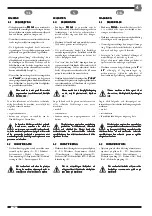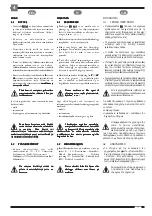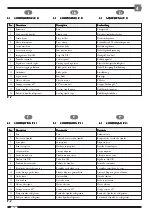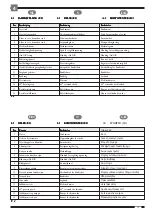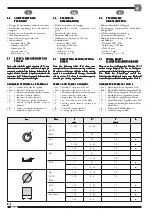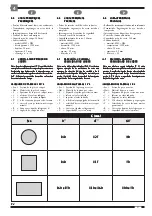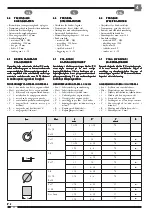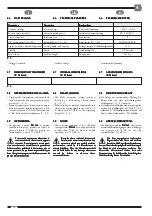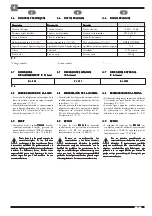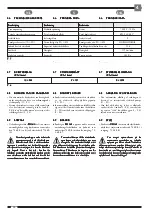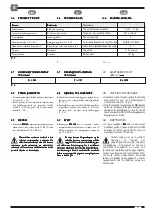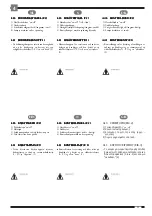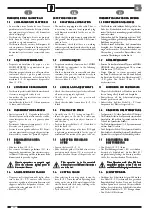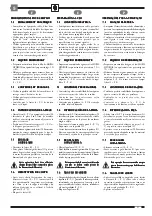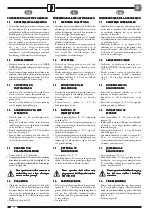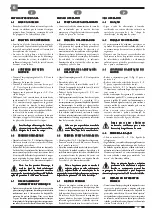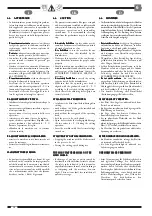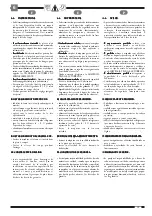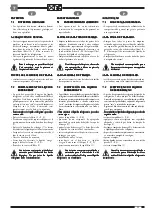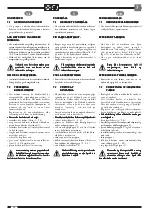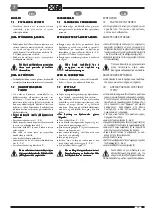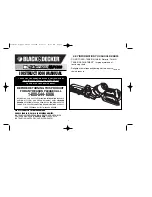
30
5
SETUP FOR THE USE
SETUP FOR THE USE
SETUP FOR THE USE
SETUP FOR THE USE
SETUP FOR THE USE
5.1
5.1
5.1
5.1
5.1
ELECTRICAL CONNECTION
ELECTRICAL CONNECTION
ELECTRICAL CONNECTION
ELECTRICAL CONNECTION
ELECTRICAL CONNECTION
• The machine is equipped with a cable. Thus, it
is necessary to mount a (new) approved plug
with dimensions suitable for the use, on the
cable end.
• Check that the supply mains is equipped with
the “ground” line as prescribed by the relevant
rules in force.
• Furthermore, check that there is a working
safety magnetothermal switch above the supply
mains to prevent from short circuits or abnormal
overloads.
5.2
5.2
5.2
5.2
5.2
COOLING LIQUID
COOLING LIQUID
COOLING LIQUID
COOLING LIQUID
COOLING LIQUID
• Prepare an emulsion of water and oil: MOBIL
HYDROIL (or equivalent) in the following
percentage: 5%
÷
8%.
• Mix for a few minutes, in a suitable and clean
container, then pour the emulsion directly in
the tank of the machine (1 – F. 4), reposition
the cover/filter (3 – F. 4).
5.3
5.3
5.3
5.3
5.3
CHECKS AND ADJUSTMENTS
CHECKS AND ADJUSTMENTS
CHECKS AND ADJUSTMENTS
CHECKS AND ADJUSTMENTS
CHECKS AND ADJUSTMENTS
• Check that the machine is perfectly stable and
all screws are properly tightened.
• Check that guards are positioned
correctly.
• Check that the blade tension lever (6 – F. 1) is
locked.
5.4
5.4
5.4
5.4
5.4
PLACING THE PIECE
PLACING THE PIECE
PLACING THE PIECE
PLACING THE PIECE
PLACING THE PIECE
• Open the vise (4 – F. 1) acting on lever (D).
• Insert the piece in the vise in a stable way
without placing any loose object between it
and the jaws.
• Position the piece holder (3 – F. 1) and lock it
with the knob (C).
• Tighten the vise acting on the lever (D). Apply
a tightening pressure suitable for the type of
material and the section of the piece to be cut.
5.5
5.5
5.5
5.5
5.5
ADJUSTING THE BLADE
ADJUSTING THE BLADE
ADJUSTING THE BLADE
ADJUSTING THE BLADE
ADJUSTING THE BLADE
GUIDE
GUIDE
GUIDE
GUIDE
GUIDE
• Loosen the lever (10 - F. 1).
• Slide the blade guide (11) which also acts as a
protection until the saw (12) is as covered as
possible, based on the size of the part to be cut.
This operation is to be executed
This operation is to be executed
This operation is to be executed
This operation is to be executed
This operation is to be executed
whenever pieces of different dimensions
whenever pieces of different dimensions
whenever pieces of different dimensions
whenever pieces of different dimensions
whenever pieces of different dimensions
are to be cut.
are to be cut.
are to be cut.
are to be cut.
are to be cut.
5.6
5.6
5.6
5.6
5.6
CUTTING ANGLE
CUTTING ANGLE
CUTTING ANGLE
CUTTING ANGLE
CUTTING ANGLE
• After selecting the cutting angle, loosen the
lever (E – F. 1), turn the whole operating head,
acting on the vise and the metal support of the
electric board with the hands, referring to the
graduated scale (F – F. 1).
• Lock the lever (E).
VORBEREITUNGEN FÜR DEN BETRIEB
VORBEREITUNGEN FÜR DEN BETRIEB
VORBEREITUNGEN FÜR DEN BETRIEB
VORBEREITUNGEN FÜR DEN BETRIEB
VORBEREITUNGEN FÜR DEN BETRIEB
5.1 ELEKTRISCHER ANSCHLUSS
5.1 ELEKTRISCHER ANSCHLUSS
5.1 ELEKTRISCHER ANSCHLUSS
5.1 ELEKTRISCHER ANSCHLUSS
5.1 ELEKTRISCHER ANSCHLUSS
• Die Maschine wird inklusive Kabel geliefert. Am
Ende des Elektrokabels muß ein zugelassener
(neuer) Stecker mit verwendungsgerechten Maßen
montiert werden.
• Sicherstellen, daß die Netzanlage mit einer “Erd”-
Leitung gemäß den geltenden Spezifikationen und
Richtlinien ausgestattet ist.
• Darüber hinaus sicherstellen, daß stromaufwärts
bezüglich der Netzanlage ein funktionierender
magnetothermischer Sicherheitsschalter zur
Überwachung eventueller Kurzschlüsse oder
anomaler Überlastungen vorhanden ist.
5.2
5.2
5.2
5.2
5.2
KÜHLFLÜSSIGKEIT
KÜHLFLÜSSIGKEIT
KÜHLFLÜSSIGKEIT
KÜHLFLÜSSIGKEIT
KÜHLFLÜSSIGKEIT
• Bereiten Sie eine Emulsion mit Wasser und MOBIL
HYDROIL (oder gleichwertigem) Öl in einem
Verhältnis von 5%
÷
8% vor.
• Einige Minuten in einem passenden und
sauberen Behälter mischen und anschließend
die Emulsion direkt in den Maschinentank (1
- F.4) geben. Den Deckel / Filter (3 - F.4)
wiedereinsetzen.
5.3
5.3
5.3
5.3
5.3
KONTROLLEN UND EINSTELLUNGEN
KONTROLLEN UND EINSTELLUNGEN
KONTROLLEN UND EINSTELLUNGEN
KONTROLLEN UND EINSTELLUNGEN
KONTROLLEN UND EINSTELLUNGEN
• Die perfekte Stabilität der Maschine sowie den
festen Anzug aller Schrauben überprüfen.
• Kontrollieren, ob die Schutzvorrichtungen
korrekt positioniert sind.
• Sicherstellen, daß der Hebel (6 - F.1) zum
Anspannen des Blattes festgestellt ist.
5.4
5.4
5.4
5.4
5.4
EINSETZEN DES WERKSTÜCKS
EINSETZEN DES WERKSTÜCKS
EINSETZEN DES WERKSTÜCKS
EINSETZEN DES WERKSTÜCKS
EINSETZEN DES WERKSTÜCKS
• Den Spannstock (4 - F.1) öffnen. Dazu den Hebel (D) betätigen.
• Das Werkstück stabil in den Spannstock einsetzen und
darauf achten, daß sich kein Gegenstand zwischen dem
Teil und den Spannbacken befindet.
• Das Werkstückspannelement (3 - F.1) positionieren und
mit dem Knauf (C) sichern.
• Durch Betätigen des Hebels (D) den Spannstock festziehen.
Beim Ausüben des Festziehdrucks müssen Werkstofftyp und
Querschnitt des zu sägenden Teils berücksichtigt werden.
5.5
5.5
5.5
5.5
5.5
REGULIERUNG DER
REGULIERUNG DER
REGULIERUNG DER
REGULIERUNG DER
REGULIERUNG DER
BLATTFÜHRUNG
BLATTFÜHRUNG
BLATTFÜHRUNG
BLATTFÜHRUNG
BLATTFÜHRUNG
• Den Hebel (10 - F. 1) lösen.
• Das Blattführungselement (11) verschieben,
das auch als Schutz dient, bis das Blatt (12)
möglichst wenig freiliegt, und zwar je nach der
Größe des zu schneidenden Werkstückes.
Diese Operation muß jedes Mal dann
Diese Operation muß jedes Mal dann
Diese Operation muß jedes Mal dann
Diese Operation muß jedes Mal dann
Diese Operation muß jedes Mal dann
ausgeführt werden, wenn Teile mit
ausgeführt werden, wenn Teile mit
ausgeführt werden, wenn Teile mit
ausgeführt werden, wenn Teile mit
ausgeführt werden, wenn Teile mit
verschiedenen Maßen gesägt werden müssen.
verschiedenen Maßen gesägt werden müssen.
verschiedenen Maßen gesägt werden müssen.
verschiedenen Maßen gesägt werden müssen.
verschiedenen Maßen gesägt werden müssen.
5.6
5.6
5.6
5.6
5.6
SCHNITTWINKEL
SCHNITTWINKEL
SCHNITTWINKEL
SCHNITTWINKEL
SCHNITTWINKEL
• Nachdem der Schnittwinkel gewählt wurde,
den Hebel (E - F.1) lockern und den gesamten
Baueinheitskopf drehen. Dazu mit der Hand
auf den Spannstock sowie auf die metallische
Auflage der elektrischen Schalttafel einwirken
und auf die Gradskala (F - F.1) Bezug nehmen.
• Den Hebel (E) blockieren.
PREDISPOSIZIONI ALL’IMPIEGO
PREDISPOSIZIONI ALL’IMPIEGO
PREDISPOSIZIONI ALL’IMPIEGO
PREDISPOSIZIONI ALL’IMPIEGO
PREDISPOSIZIONI ALL’IMPIEGO
5.1
5.1
5.1
5.1
5.1
COLLEGAMENTO ELETTRICO
COLLEGAMENTO ELETTRICO
COLLEGAMENTO ELETTRICO
COLLEGAMENTO ELETTRICO
COLLEGAMENTO ELETTRICO
• La macchina viene fornita di cavo. Occorre
quindi montare all’estremità del cavo elettrico
una spina omologata (nuova) e di dimensioni
adatte all’impiego.
• Verificare che l’impianto di rete sia provvisto
della linea di “terra” come previsto dalle
specifiche e vigenti normative.
• Verificare inoltre che a monte dell’impianto di
rete sia presente e funzionante l’interruttore di
sicurezza magnetotermico, per la salvaguardia
da eventuali corto circuiti o sovraccarichi ano-
mali.
5.2
5.2
5.2
5.2
5.2
LIQUIDO REFRIGERANTE
LIQUIDO REFRIGERANTE
LIQUIDO REFRIGERANTE
LIQUIDO REFRIGERANTE
LIQUIDO REFRIGERANTE
• Preparare un’emulsione di acqua e olio:
MOBIL HYDROIL (o equivalente) in per-
centuale: 5%
÷
8%.
• Miscelare per qualche minuto, all’interno di un
contenitore adatto e pulito, quindi versare
l’emulsione direttamente nel serbatoio della
macchina (1 - F. 4), riposizionare il coperchio/
filtro (3 - F. 4).
5.3
5.3
5.3
5.3
5.3
CONTROLLI E REGOLAZIONI
CONTROLLI E REGOLAZIONI
CONTROLLI E REGOLAZIONI
CONTROLLI E REGOLAZIONI
CONTROLLI E REGOLAZIONI
• Verificare la perfetta stabilità della macchina ed
il corretto serraggio di tutte le viti.
• Controllare che le protezioni siano corretta-
mente posizionate.
• Controllare che la leva (6 - F. 1) di tensionamen-
to lama, risulti bloccata.
5.4
5.4
5.4
5.4
5.4
INSERIMENTO DEL PEZZO
INSERIMENTO DEL PEZZO
INSERIMENTO DEL PEZZO
INSERIMENTO DEL PEZZO
INSERIMENTO DEL PEZZO
• Aprire la morsa (4 - F. 1) agendo sulla leva (D).
• Inserire il pezzo nella morsa in modo stabile,
senza interporre fra esso e le ganasce alcun
oggetto.
• Posizionare l’elemento ferma pezzo (3 - F. 1) e
bloccarlo con il pomello (C).
• Serrare la morsa agendo sulla leva (D). Eserci-
tare una pressione di serraggio adeguata al tipo
di materiale e sezione del pezzo da tagliare.
5.5
5.5
5.5
5.5
5.5
REGOLAZIONE GUIDA
REGOLAZIONE GUIDA
REGOLAZIONE GUIDA
REGOLAZIONE GUIDA
REGOLAZIONE GUIDA
LAMA
LAMA
LAMA
LAMA
LAMA
• Allentare la leva (10 - F. 1).
• Far scorrere l’elemento guidalama (11), che
funge anche da protezione, fino a lasciare scoper-
ta la lama (12) il meno possibile, in funzione della
dimensione del pezzo da tagliare.
Questa operazione va eseguita ogni
Questa operazione va eseguita ogni
Questa operazione va eseguita ogni
Questa operazione va eseguita ogni
Questa operazione va eseguita ogni
volta che si devono tagliare pezzi di
volta che si devono tagliare pezzi di
volta che si devono tagliare pezzi di
volta che si devono tagliare pezzi di
volta che si devono tagliare pezzi di
dimensioni diverse.
dimensioni diverse.
dimensioni diverse.
dimensioni diverse.
dimensioni diverse.
5.6
5.6
5.6
5.6
5.6
ANGOLAZIONE DI TAGLIO
ANGOLAZIONE DI TAGLIO
ANGOLAZIONE DI TAGLIO
ANGOLAZIONE DI TAGLIO
ANGOLAZIONE DI TAGLIO
• Dopo aver scelto l’angolazione di taglio, allen-
tare la leva (E - F. 1), ruotare tutta la testa
operatrice, agendo con le mani sulla morsa e sul
supporto metallico del quadro elettrico, rife-
rendosi alla scala graduata (F - F. 1).
• Bloccare la leva (E).
I
UK
D
Summary of Contents for PH160
Page 51: ......

